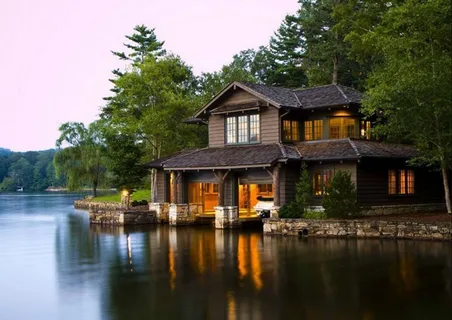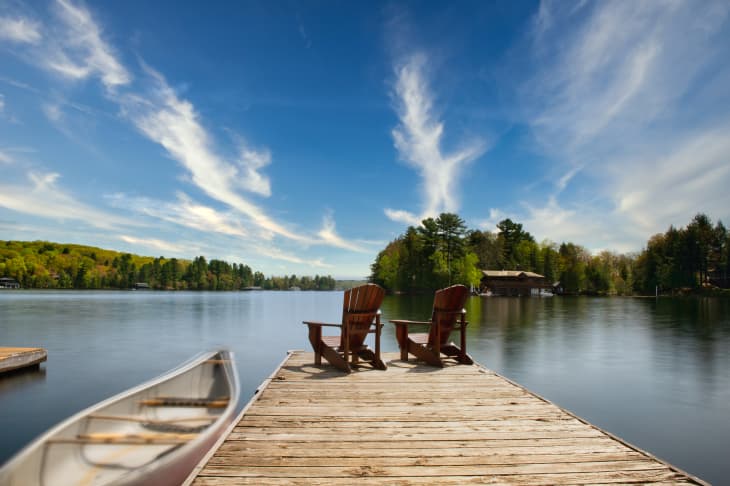
Taking the plunge on waterfront life involves more than just a hefty price tag. For all the perks of buying a lake house (of which there are many!). There are also a few tedious downsides that need to be considered and budgeted. For before you buy your first boat or jump on a jet ski.
From unexpected expenses and hefty insurance premiums to routine maintenance. that goes beyond your normal in-town home. Many buyers might prefer to stick their head in the sand. And focus on sunny days spent relaxing with seltzer in hand. But four real estate agents with lakeside experience from coast to coast shared. Their experiences with helping clients buy waterfront property. They highlighted five things nobody tells you about buying a house on a lake. But that you definitely need to consider before you sail away.
Do Your Research on Flood Plains
It’s not just rivers and oceans that flood — lakes can surge with heavy rains, too. Brett Rosenthal, a real estate agent in the greater Philadelphia area. Explains that depending on the flood plain, a lakefront property could be at risk of being flooded in the event of heavy rains or severe weather. “Extra insurance is required to be purchased in these situations and can be costly,” he says.
Look carefully at local flood plain maps and don’t assume that just because you don’t fall within a high-risk area means you’re out of the woods. Use common sense in addition to the FEMA maps. Talk to neighbors, observe whether there are low-lying portions of your property, and look for existing damage within the basement and first floor spaces.
Kimo Quance, a real estate agent in San Diego, notes that it isn’t solely the flood risk that can raise insurance. “Insurance is typically much higher for lakefront properties because of the risk of injury to residents of the home,” he adds. “The sort of coverage you require may be mandated by local regulations or even a lender.”

Plan for Riprap Maintenance
Rob Kittle of Kittle Real Estate in Colorado points out, “No matter where your lake is located, you’ll almost certainly have some level of shoreline erosion. This is more impactful when the water level fluctuates throughout the year with varying tide levels and possible shore breaks. Even a relatively calm lake will have a constant ebb and flow of water movement on the shore.”
That’s why not only are those stately stone barriers lining the coastline pretty to look at, they also play a critical role in preventing erosion and, yes, preventing your house from falling into the water (you’ve seen this video, right?!).
Fortunately, it’s not something that needs to be done regularly. Most riprap coastlines should last several decades, but it’s something you should consider when buying a lakefront home. Will your riprap need to be repaire in the next few year? If so, you may want to add another several ten of thousands to the price you planned on paying for your home. Additionally, there may be permitting required with the Department of Natural Resources or the Army Corps of Engineers, among other groups, depending on the location and condition. This can cost both time and money.
Look into Water Quality
A dip in your new front yard should be refreshing. But before you take the plunge, make sure you’ve checked that the water is actually safe for swimming. Depending on the season, local runoff, or nearby factories and businesses, there could be times when the water is off-limits for swimmers — and this is information you want in hand before signing on the dotted line.
Assess the Exterior Condition of Your Home
Weather can be tough on a place. And when you’re lakefront, wind and water causes, even more, wear and tear. “Lake water and humidity can result in a mold that may be devastating to a home’s structure,” says Robert J. Fischer, owner and broker with the Robert J. Fischer Team in Austin, Texas. Siding, roofing, and windows will all need regular maintenance to address the issues that come up from continued exposure to moist environments.
Familiarize Yourself with the Other “Neighbors”
Friendly neighbors are great… furry neighbors, well, they’re cute. But you may not want them near your lake house. “Semi-aquatic rodents burrow into your yard and property from tunnels they make on the shoreline,” Kittle explains.
These tunnels can collapse, creating a saggy, soggy lawn, sinkholes, flooding, and more House. The only way to combat them is to install muskrat-proof material along the shoreline that stops them from starting their tunnels. Typically, this must be tackled by a professional and, you guessed it, it’s not a cheap project.
Additionally, depending on how still the water is, mosquitoes and other water-loving insects may accompany you on any given day. Kittle says, “It’s amazing how being close to bodies of water exponentially increases your mosquito bites and annoyances, especially if you’re someone they like to feast on.”
MORE DETAILS:
technologymedia.net
MORE DETAILS:
A lonely doctor who once occupied an unusual lakeside house begins to exchange love letters with its former resident, a frustrated architect. They must try to unravel the mystery behind their extraordinary romance before it’s too late.






